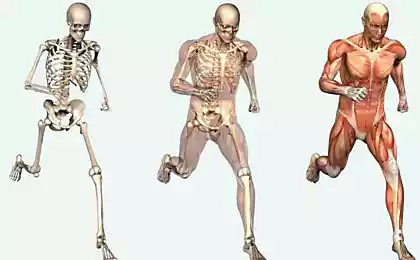726
Interval training: maximum health benefits in less time
If you're still not doing interval training, you will most likely spend an awful lot of time in the gym. This is one of the most important achievements in fitness science that I can think of, in fact, thanks to these workouts, you can extract a lot more health benefits in less time.

But lately, I'm talking more about the potentialbenefits of periodic fasting for health and workouts on an empty stomach (i.e. no Breakfast before training).
Training on an empty stomach essentially cause the body to lose fat because the processes of fat-burning in the body controlled by the sympathetic nervous system (SNS) that is activated by exercise and lack of food. The combination of fasting and exercising maximizes the impact of cellular factors and catalysts (cyclic AMP and AMP-kinase), which forcibly breaks down fats and glycogen for energy.
We all get more data to support this strategy, and I think it is very useful, provided that you have already made some fundamental changes in your lifestyle in terms of diet and exercise.
Together, high-intensity exercise and intermittent fasting can be a winning strategy to further improve your physical fitness.
Keep in mind that fasting or exercise on an empty stomach will not have much sense, if your diet still full of processed foods, so before trying any kind of fasting is absolutely necessary to decide the question of power.
In addition, when you restrict your calorie intake, whether in the form of periodic fasting or simply skipping Breakfast, it is very important to cut the right calories, namely carbohydrates (i.e., sugars and grain, not vegetable carbs).
Restricting carbohydrates improves the parameters in elite athletes:
A recent study from the Swedish school of sport and science on здоровье1 proved that the restriction of carbohydrates to more effectively burns calories and increases oxidative capacity of muscle, even in well-trained athletes.
Ten high level cyclists in an hour doing interval training at approximately 64 per cent of their maximal aerobic capacity if low or normal muscle glycogen levels that had been reached pre-exercise or changes in diet. Before training and three hours after she had taken a biopsy of the muscle.
The results showed that exercise in a state of depleted glycogen stores increase mitochondrial biogenesis. (Mitochondrial biogenesis is the process of formation of new mitochondria in cells.)
According to the authors:
"We came to the conclusion that exercising with low glycogen levels amplifies the expression of the main genetic markers of mitochondrial biogenesis in well-trained cyclists. These results indicate that exercise with low glycogen levels can be useful for improvement of oxidative capacity of muscle".
Part of the effectiveness of training on an empty stomach is because the body has a preservation mechanism that protects active muscles from spending. So, if you have enough fuel when you exercise, you destroy other tissues but not the active muscle, i.e. the muscles that you train.
According to fitness expert ori of Hofmekler, author of "Diet warrior", you can literally rebuild your body physically through malnutrition and exercises. But this can help only if you are adapted to fat, which means that the metabolism is able to burn fat.
Interval training burn more calories in less time the news mentioned a study presented at the VI meeting, the Integrative biology of exercise, Colorado October 10-13 this year, demonstrated that high-intensity interval training burns more calories in less time — in just 2.5 minutes, divided into five 30-second intervals at maximum load, each of which is interleaved four minutes of leisurely Cycling to recuperate, can burn as many as 220 calories.
Overall, less than 25 minutes you can burn more calories than Cycling at a moderate pace for half an hour.
According to lead researcher, exercise physiology Kyle Sevits:
"You burn a lot of calories in a very short period of time... Almost all calories burned for 2.5 minutes, even a little bit- in the dormant period". He also points to additional benefits of interval training, including increased insulin sensitivity and glucose tolerance, which are important for General good health".
High intensity interval training, which are part of my total Peak fitness program, has also shown that the best beneficial effect on your health than regular aerobic exercise. Back in April I reported about a study that found that just three minutes of high-intensity workouts a week for four weeks can significantly change important indicators of health status, including 24 per cent to improve insulin sensitivity.
Another important advantage of high-intensity interval training is their ability to naturally increase the body's production of human growth hormone, also known the "fitness hormone". HGH is a synergistic, foundational biochemical element that contributes to increase muscle strength and effectively burn excess fat.
It also plays an important role in ensuring the General health and life expectancy. And this is why you don't get from conventional, aerobic endurance training.

How to maximize the health benefits of Peak fitness Theoretically, of course, it is possible to get valuable results in just three minutes (plus rest periods between sets) once a week, but still better to dotwo or three workouts per week, a total of four minutes of intense exercise during a single workout, especially if you are doing strength training.
Most high intensity exercises you don't need. In fact, the implementation of them often two or three times a week can be counterproductive, because the body needs to recover between workouts.
Intensity is the KEY to all the benefits of interval training. To do it right, you need to raise your heart rate to your anaerobic threshold, and it needs to train struggling for 20-30 seconds. In different studies use different intervals of stress and recovery.
For example, in a study of top-class athletes, a surge was divided into four-minute rest intervals. But during physical activity, they are also not "hard".
I use myself and recommend to you a software program developed by Phil Campbell – starts the production of human growth hormone when you are struggling to carry out physical activity. Here is a brief description of regular interval training on the elliptical trainer:
Body fat reduction
The increase in muscle tone
Increase speed and other sports results
The opportunity to achieve fitness goals much faster
The increase in energy and sexual desire
The skin is more elasticity, fewer wrinkles
Exercise is the key to body fat reduction and muscle preservation, I have repeatedly claimed that 80 percent of health benefits gives diet and the other 20 is exercise. However, it is important to understand that they interact at a deep level, as shown by another recent study.
The researchers analyzed data from 11 participants in the reality show "Suspended people." Three times they measured total body fat, total energy expenditure and metabolic rate at rest: in the beginning of the program, six weeks of participation in the program and 30 weeks, i.e., at least four months after the participants returned home.
Using a mathematical computer model of human metabolism, the researchers calculated the impact of diet and exercise changes that lead to weight loss, to evaluate the relative contribution of each of them.
Interestingly, although the diet itself is considered as a whole responsible for greater weight loss than exercise, fat made up only 65 percent of the dropped weight.The rest of the reduction of body weight by 35 percent had a decrease in muscle mass. In itself the exercise led to the loss of only fat, along with a small increase in muscle mass.
According to a press release from the National Institute of health:
"Modelling also suggests that the participants were able to maintain weight loss and avoid the re-set with more moderate lifestyle changes – like 20 minutes of daily vigorous exercise and calorie restriction by 20 percent than those who were shown in a TV program".
Tips on safe fasting and exercise: a very important meal after a workout, Effective exercise program incorporating high-intensity interval training combined with intermittent fasting can help counteract aging and loss of muscle and stimulate fat burning.
If at some point you have enough energy or you feel unwell, then perhaps it's time to experiment – reduce the hours of fasting. Due to the periodic fasting you should be better, but if not, you should rethink your strategy.
Make sure you remember these two aspects:

Author: Dr. Joseph Mercola
P. S. And remember, only by changing their consumption - together we change the world! ©
Source: russian.mercola.com/sites/articles/archive/2016/12/23/%D0%B8%D0%BD%D1%82%D0%B5%D1%80%D0%B2%D0%B0%D0%BB%D1%8C%D0%BD%D1%8B%D0%B5-%D1%82%D1%80%D0%B5%D0%BD%D0%B8%D1%80%D0%BE%D0%B2%D0%BA%D0%B8.aspx

But lately, I'm talking more about the potentialbenefits of periodic fasting for health and workouts on an empty stomach (i.e. no Breakfast before training).
Training on an empty stomach essentially cause the body to lose fat because the processes of fat-burning in the body controlled by the sympathetic nervous system (SNS) that is activated by exercise and lack of food. The combination of fasting and exercising maximizes the impact of cellular factors and catalysts (cyclic AMP and AMP-kinase), which forcibly breaks down fats and glycogen for energy.
We all get more data to support this strategy, and I think it is very useful, provided that you have already made some fundamental changes in your lifestyle in terms of diet and exercise.
Together, high-intensity exercise and intermittent fasting can be a winning strategy to further improve your physical fitness.
Keep in mind that fasting or exercise on an empty stomach will not have much sense, if your diet still full of processed foods, so before trying any kind of fasting is absolutely necessary to decide the question of power.
In addition, when you restrict your calorie intake, whether in the form of periodic fasting or simply skipping Breakfast, it is very important to cut the right calories, namely carbohydrates (i.e., sugars and grain, not vegetable carbs).
Restricting carbohydrates improves the parameters in elite athletes:
A recent study from the Swedish school of sport and science on здоровье1 proved that the restriction of carbohydrates to more effectively burns calories and increases oxidative capacity of muscle, even in well-trained athletes.
Ten high level cyclists in an hour doing interval training at approximately 64 per cent of their maximal aerobic capacity if low or normal muscle glycogen levels that had been reached pre-exercise or changes in diet. Before training and three hours after she had taken a biopsy of the muscle.
The results showed that exercise in a state of depleted glycogen stores increase mitochondrial biogenesis. (Mitochondrial biogenesis is the process of formation of new mitochondria in cells.)
According to the authors:
"We came to the conclusion that exercising with low glycogen levels amplifies the expression of the main genetic markers of mitochondrial biogenesis in well-trained cyclists. These results indicate that exercise with low glycogen levels can be useful for improvement of oxidative capacity of muscle".
Part of the effectiveness of training on an empty stomach is because the body has a preservation mechanism that protects active muscles from spending. So, if you have enough fuel when you exercise, you destroy other tissues but not the active muscle, i.e. the muscles that you train.
According to fitness expert ori of Hofmekler, author of "Diet warrior", you can literally rebuild your body physically through malnutrition and exercises. But this can help only if you are adapted to fat, which means that the metabolism is able to burn fat.
Interval training burn more calories in less time the news mentioned a study presented at the VI meeting, the Integrative biology of exercise, Colorado October 10-13 this year, demonstrated that high-intensity interval training burns more calories in less time — in just 2.5 minutes, divided into five 30-second intervals at maximum load, each of which is interleaved four minutes of leisurely Cycling to recuperate, can burn as many as 220 calories.
Overall, less than 25 minutes you can burn more calories than Cycling at a moderate pace for half an hour.
According to lead researcher, exercise physiology Kyle Sevits:
"You burn a lot of calories in a very short period of time... Almost all calories burned for 2.5 minutes, even a little bit- in the dormant period". He also points to additional benefits of interval training, including increased insulin sensitivity and glucose tolerance, which are important for General good health".
High intensity interval training, which are part of my total Peak fitness program, has also shown that the best beneficial effect on your health than regular aerobic exercise. Back in April I reported about a study that found that just three minutes of high-intensity workouts a week for four weeks can significantly change important indicators of health status, including 24 per cent to improve insulin sensitivity.
Another important advantage of high-intensity interval training is their ability to naturally increase the body's production of human growth hormone, also known the "fitness hormone". HGH is a synergistic, foundational biochemical element that contributes to increase muscle strength and effectively burn excess fat.
It also plays an important role in ensuring the General health and life expectancy. And this is why you don't get from conventional, aerobic endurance training.

How to maximize the health benefits of Peak fitness Theoretically, of course, it is possible to get valuable results in just three minutes (plus rest periods between sets) once a week, but still better to dotwo or three workouts per week, a total of four minutes of intense exercise during a single workout, especially if you are doing strength training.
Most high intensity exercises you don't need. In fact, the implementation of them often two or three times a week can be counterproductive, because the body needs to recover between workouts.
Intensity is the KEY to all the benefits of interval training. To do it right, you need to raise your heart rate to your anaerobic threshold, and it needs to train struggling for 20-30 seconds. In different studies use different intervals of stress and recovery.
For example, in a study of top-class athletes, a surge was divided into four-minute rest intervals. But during physical activity, they are also not "hard".
I use myself and recommend to you a software program developed by Phil Campbell – starts the production of human growth hormone when you are struggling to carry out physical activity. Here is a brief description of regular interval training on the elliptical trainer:
- Warm up for three minutes.
- Perform each exercise as hard and fast as you can for 30 seconds. You have to gasp for breath and feel like I can't hold out a second longer. To increase the heart rate, it is better to use less resistance and more reps.
- Recovery for 90 seconds – do the exercise but at a slower pace and with reduced resistance.
- Repeat high intensity exercise and recovery 7 more times.
Body fat reduction
The increase in muscle tone
Increase speed and other sports results
The opportunity to achieve fitness goals much faster
The increase in energy and sexual desire
The skin is more elasticity, fewer wrinkles
Exercise is the key to body fat reduction and muscle preservation, I have repeatedly claimed that 80 percent of health benefits gives diet and the other 20 is exercise. However, it is important to understand that they interact at a deep level, as shown by another recent study.
The researchers analyzed data from 11 participants in the reality show "Suspended people." Three times they measured total body fat, total energy expenditure and metabolic rate at rest: in the beginning of the program, six weeks of participation in the program and 30 weeks, i.e., at least four months after the participants returned home.
Using a mathematical computer model of human metabolism, the researchers calculated the impact of diet and exercise changes that lead to weight loss, to evaluate the relative contribution of each of them.
Interestingly, although the diet itself is considered as a whole responsible for greater weight loss than exercise, fat made up only 65 percent of the dropped weight.The rest of the reduction of body weight by 35 percent had a decrease in muscle mass. In itself the exercise led to the loss of only fat, along with a small increase in muscle mass.
According to a press release from the National Institute of health:
"Modelling also suggests that the participants were able to maintain weight loss and avoid the re-set with more moderate lifestyle changes – like 20 minutes of daily vigorous exercise and calorie restriction by 20 percent than those who were shown in a TV program".
Tips on safe fasting and exercise: a very important meal after a workout, Effective exercise program incorporating high-intensity interval training combined with intermittent fasting can help counteract aging and loss of muscle and stimulate fat burning.
If at some point you have enough energy or you feel unwell, then perhaps it's time to experiment – reduce the hours of fasting. Due to the periodic fasting you should be better, but if not, you should rethink your strategy.
Make sure you remember these two aspects:
- Meals: intermittent fasting is not extreme calorie restriction. No need to starve yourself. It is rather a question of schedule meals when most of the day you refrain from eating, reducing it to a small interval in the evening. If you have limited meal 16:00-19:00, you would have starved, in fact, in 21 hours.Ideally, this period should be at least 12-18 hours.

- If you can't abstain from eating completely during the day, limit yourself to small servings of light, low-glycemic, mostly raw foods, such as fruits, vegetables, whey protein or just welded to the eggs every 4-6 hours. Whatever mealtime you choose, it will be very useful to refuse food or calories for three hours before bedtime – this will minimize the oxidative damage to your system and will help the body go to periodic starvation.
- During training dilute your post recovery meal when you exercise on an empty stomach, eat recovery meals in 30 minutes after a workout.The ideal would be bystroshvatyvajushchijsja whey protein. Then fast again until you eat the main meal in the evening. It is very important that after a workout, you eat an appropriate recovery meal — this will prevent damage to the brain and muscles, so don'T skip this meal.
If fasting for 12-18 hours is too much for you, then the beneficial effects of fasting and exercise you can get, simply skipping Breakfast and exercising on an empty stomach in the morning when the stomach is empty. This is because eating a full meal, particularly carbohydrates, prior to exercise will suppress the sympathetic nervous system and reduce the fat burning effect of your workout. Instead of eating lots of carbs activates your parasympathetic nervous system, which promotes energy storage – and this is exactly what every way you try to avoid). published
Author: Dr. Joseph Mercola
P. S. And remember, only by changing their consumption - together we change the world! ©
Source: russian.mercola.com/sites/articles/archive/2016/12/23/%D0%B8%D0%BD%D1%82%D0%B5%D1%80%D0%B2%D0%B0%D0%BB%D1%8C%D0%BD%D1%8B%D0%B5-%D1%82%D1%80%D0%B5%D0%BD%D0%B8%D1%80%D0%BE%D0%B2%D0%BA%D0%B8.aspx
Useful beet drink that will love even the kids!
5 myths about children and parents, which is to debunk























